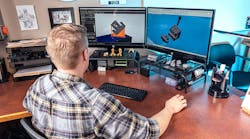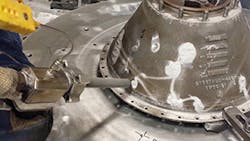Shon Anderson wants to reverse the trend of Rapid City, South Dakota, graduates leaving the state to gain work experience.
This was the path that Anderson took before he became the CEO of B9Creations. The company, started by former Ellsworth Air Force Base B-1B bomber pilot Mike Joyce in 2011, manufactures 3D printers that serve markets including manufacturing, jewelry, research and medical devices. According to Anderson, they have the world’s only 3D printer that meets medical device standards.
“My passion is to develop people to enable them to reach their highest potential,” says Anderson. “I want to see this area continue to develop an economy that provides opportunities in advanced manufacturing.”
The story of how this company grew exemplifies how advanced technology is creating a manufacturing ecosystem in Rapid City.
B9Creations initially received funding from Kickstarter for its first machine. In 2014, the company moved from Joyce’s garage to an incubator, called Ascent Innovation, located on the campus of the South Dakota School of Mines & Technology (SD Mines). Further expansion due to the production of new printers led the company to open an 18,000 square- foot manufacturing plant in January of 2019.
As the product line expanded so has the workforce, which currently is at 30 but expected to hit 50. And revenue will grow from $7 million to $25 million.
“Our growth couldn’t have happened without the support of a number of organizations that provided a variety of resources,” says Anderson. Those organizations include the Rapid City economic development partnership, the state office of economic development, workforce programs, and continued guidance from Ascent Innovation.
“Ascent Innovation was created after an economic study of the area determined that the region needed to diversify,” explains Terri Haverly, executive director at Ascent Innovation. “So, we created an incubator to support manufacturing and technology-related companies.”
And locating the center on the campus of SD Mines moved things along in the direction of building a community. The center has 30,000 square feet for start-up and research purposes and 10,000 square feet housing a variety of other resources. “Ascent innovation is more than a space to work, “says Haverly. “It’s an invitation to join a community dedicated to bringing their ideas to life in Rapid City.”
And that’s just what is happening. For VCR Metal Systems, Ascent Innovation was also the starting point. Interestingly this company has a military connection. Rob Hrabe, also a B-1B pilot, formed VRC Metal Systems to commercialize cold spray technology which sprays metal powder at supersonic speeds and is used to repair irreplaceable parts on Department of Defense weapons systems. The company had support from both the Army Research Lab and SD Mines.
When Fort Ellsworth appeared on a BRAC list, which means the base would close, Hrabe was consulting with the military as to ways to transition technology out of the base and into a commercial environment. Hrabe’s ability to bridge the gap between the engineering world and the operations world led him to realize that the cold spray technology would be able to save hundreds of millions of dollars since parts that get corroded need to be replaced.
“South Dakota’s a good place to start a business because a lot of people are willing to help and there is not a lot of manufacturing out here and therefore not a lot of competition,” explains Hrabe. He pointed out that SD Mines is an especially useful source as it is only one of five programs nationally that offer degrees in metallurgy. He worked with the school to develop the product and the school actually owns the patent to the technology. His company holds exclusive rights to the technology.
Currently, the company employs 60 but will be up to 75 by the end of this year and plans to add another 25 jobs next year. The company has $17 million in contracts spread out over the next several years and Hrabe predicts they will add another $6 million to that.
This additional talent will have to come from somewhere and Hrabe has been working hard to recruit area college students. He hires college students as interns and then offers jobs to those that are a good fit. Like Anderson, he presents manufacturing as an exciting, innovative and highly technical career that is located in their backyard.
A good source of talent for the area has been SD Mine which has a strong internship and co-op program. In the last five years alone, graduates (97% find jobs) have accepted jobs with nearly 150 employers in South Dakota communities
Another source of talent for VCR Metal Systems are veterans. “They are the ones that have worldly experience, says Hrabe. “They know how to manage projects and deal with colleagues.” He is looking to this talent pool as being a key component of future growth over the next few years.
Continuing to recruit veterans is part of Haverly’s strategy as a way to increase the manufacturing’s share of state revenues, which are currently at $1.9 billion. Over one-third of the companies in Ascent Innovation have a connection to the Department of Defense either through contracts or they are staffed by veterans. She plans to continue to reach out to veterans by holding networking events, which she does for companies housed at Ascent Innovation, specifically to connect them to growing companies.
Planning, such as the networking events for veterans, is part of a pro-active workforce strategy that the region in pursuing. Recently an organization called Elevate Rapid City was formed. It’s a public-private partnership whose top priority is the creation and retention of primary and secondary jobs.
To Hrabe’s way of viewing the creation and retention of jobs in the area, “it comes down to being able to use technology to present exciting job opportunities that young people would be interested in. Combine those workers with the skills that military people bring to the table and it’s a winning formula.”





